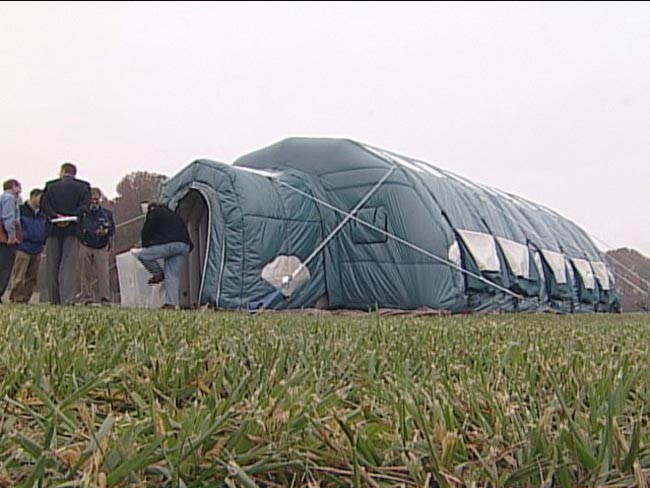Inflatable Moon Base Prototype Heads to South Pole

Aninflatable habitat designed for explorers on the moon or Mars is headed for anAntarctic test run, NASA said Wednesday.
The habitat– built by ILC Dover and resembling an inflatable backyard bounce for children– will make its South Pole debut early next year. NASA demonstrated theinflatable prototype on Wednesday at ILC Dover's Frederica, Del., facility.
"Wedeflated [and inflated] it in about ten minutes," said Larry Toups,habitat lead for NASA's Constellation Program Lunar Surface Systems Office, inan interview.
Toups andseveral other habitat designers from NASA's Johnson Space Center and ILC Doverwill attempt to deploy the structure in the Antarctic this coming January.Their goal: to use just four people and deploy everything in four hours.Working in bulky cold weather gear will also make the deployment more analogousto the challenges facing astronauts clad in cumbersome spacesuits on the moon.
The habitatprototype will eventually serve as a multilayered test platform for newtechnologies such as health monitoring systems, self-healing materials, andprotective radiation materials. When not inflated, the habitat can save onspace and weight during transportation. It's just one of several models,including another prototype that standson eight legs and has two pressurized cylinders connected by an airlockdoor, under scrutiny by NASA engineers.
Otherresearchers at McMurdo Station in Antarctica will use the inflated habitat as a staging area from January 2008 toFebruary 2009, allowing the designers to monitor its performance using human reportsas well as data from embedded sensors. NASA and the National Science Foundationhope to learn how the habitat material behaves in a cold environment and howwell the structure retains heat and atmosphere.
Toups saidthe field demonstration will show that the structure can be "packaged in asmall volume" but still "expandto a usable, habitable volume," even in an extreme environment. IfNASA likes what it sees, a second or third generation inflatable habitat coulddeploy to the moon as early as 2020, with four-person crews making weeklongtrips to get a lunar base operational.
Get the Space.com Newsletter
Breaking space news, the latest updates on rocket launches, skywatching events and more!
The U.S. space agency is not alone in considering inflatableliving modules. A private company, the Las Vegas, Nev.-based Bigelow Aerospace,has already launchedtwo inflatable modules into Earth orbit in anticipation of assembling a newspace station by 2012.
- VIDEO: Tour One of NASA's Inflatable Lunar Module Prototype
- VOTE NOW! The Best Moon Image
- VIDEO: Moon 2.0: Join the Revolution
Join our Space Forums to keep talking space on the latest missions, night sky and more! And if you have a news tip, correction or comment, let us know at: community@space.com.
Jeremy Hsu is science writer based in New York City whose work has appeared in Scientific American, Discovery Magazine, Backchannel, Wired.com and IEEE Spectrum, among others. He joined the Space.com and Live Science teams in 2010 as a Senior Writer and is currently the Editor-in-Chief of Indicate Media. Jeremy studied history and sociology of science at the University of Pennsylvania, and earned a master's degree in journalism from the NYU Science, Health and Environmental Reporting Program. You can find Jeremy's latest project on Twitter.









